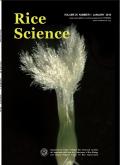A Novel Approach for Screening Salinity-Tolerant Rice Germplasm by Exploring Redox-Regulated Cytological Fingerprint
IF 5.6
2区 农林科学
Q1 AGRONOMY
引用次数: 0
Abstract
Although metabolic homeostasis disruption, cellular damage, and premature senescence caused by salinity stress are well-documented in the literature, there are few studies investigating cytological changes induced by salinity stress within the altered metabolic landscape of rice, and this study aims to fill that gap. The cytological characterization of root tips (in terms of mitotic index and chromosomal abnormalities such as stickiness, laggards, fragments, bridges, micronuclei, ring chromosomes, and total mitotic abnormalities) was conducted on 10 experimental rice landraces from coastal Bangladesh, grown under post-imbibitional salinity stress (PISS), while correlating these changes with their metabolic status. The results revealed a strong correlation between salinity-induced cytological changes in root cells (mitotic index and chromosomal abnormalities) and the redox interactome status of all experimental rice landraces. The landraces Kutepatnai, Talmugur, Nonakochi, and Benapol, which exhibited a higher ability to mitigate PISS-induced chromosomal abnormalities and improve mitotic index, also showed lower accumulation of oxidative stress markers (protein carbonylation, lipid peroxidation, prooxidant accumulation, oxidative stress index, reactive oxygen species (ROS)-antioxidative stress index, and efficiency of ROS processing via the Halliwell-Asada pathway) compared with more susceptible landraces (Charobalam, Jotaibalam, Kachra, and Lalmota). These findings underscore the role of redox biology in preventing chromotoxic effects under salinity stress. Hierarchical cluster analysis and principal component analysis, used to determine variations and similarities among the experimental rice landraces based on cytological attributes, redox interactome, and physiological phenotypes, classified the landraces according to their salinity tolerance and sensitivity. This study proposes a novel approach for exploring redox-regulated cytological fingerprints as a tool for identifying salinity-tolerant rice landraces.
利用氧化还原调控细胞学指纹图谱筛选耐盐水稻种质的新方法
虽然盐胁迫引起的代谢稳态破坏、细胞损伤和过早衰老在文献中有很好的记载,但很少有研究调查盐胁迫在改变的水稻代谢景观中引起的细胞学变化,本研究旨在填补这一空白。对来自孟加拉国沿海地区的10个试验性地方水稻进行了根尖的细胞学表征(包括有丝分裂指数和染色体异常,如粘性、滞后、片段、桥、微核、环染色体和总有丝分裂异常),并将这些变化与它们的代谢状态联系起来。结果表明,盐诱导的根细胞细胞学变化(有丝分裂指数和染色体异常)与所有地方水稻的氧化还原相互作用体状态有很强的相关性。地方品种Kutepatnai、Talmugur、Nonakochi和Benapol表现出较强的减轻piss诱导的染色体异常和改善有丝分裂指数的能力,同时也显示出较低的氧化应激标志物(蛋白质羰基化、脂质过氧化、促氧化剂积累、氧化应激指数、活性氧(ROS)-抗氧化应激指数)的积累。和更敏感的地方品种(Charobalam, Jotaibalam, Kachra和Lalmota)相比,ROS处理效率(通过Halliwell-Asada途径)。这些发现强调了氧化还原生物学在防止盐胁迫下的色毒性作用中的作用。基于细胞学属性、氧化还原相互作用组和生理表型,利用层次聚类分析和主成分分析确定了不同地方稻品种间的差异和相似性,并根据耐盐性和敏感性对地方稻品种进行了分类。本研究提出了一种新的方法来探索氧化还原调控的细胞学指纹图谱,作为鉴定耐盐水稻地方品种的工具。
本文章由计算机程序翻译,如有差异,请以英文原文为准。
求助全文
约1分钟内获得全文
求助全文
来源期刊

Rice Science
Agricultural and Biological Sciences-Agronomy and Crop Science
CiteScore
8.90
自引率
6.20%
发文量
55
审稿时长
40 weeks
期刊介绍:
Rice Science is an international research journal sponsored by China National Rice Research Institute. It publishes original research papers, review articles, as well as short communications on all aspects of rice sciences in English language. Some of the topics that may be included in each issue are: breeding and genetics, biotechnology, germplasm resources, crop management, pest management, physiology, soil and fertilizer management, ecology, cereal chemistry and post-harvest processing.
 求助内容:
求助内容: 应助结果提醒方式:
应助结果提醒方式:


